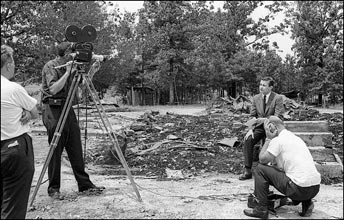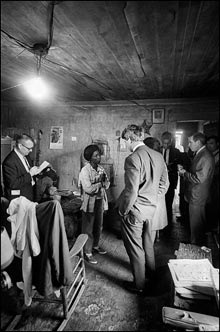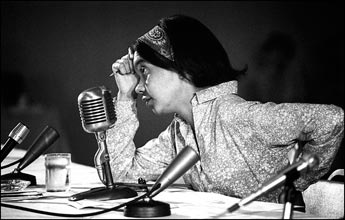Lowcountry resident Jane Hearn has curated a powerful exhibit for the 50th anniversary of Freedom Summer.
 “When you are in Mississippi, the rest of America doesn’t seem real; and when you are in the rest of America, Mississippi doesn’t seem real.” – Dr. Robert “Bob” Moses, Program Director 1961-65 Student Nonviolent Coordinating Committee.
“When you are in Mississippi, the rest of America doesn’t seem real; and when you are in the rest of America, Mississippi doesn’t seem real.” – Dr. Robert “Bob” Moses, Program Director 1961-65 Student Nonviolent Coordinating Committee.
When a South Carolina native Marian Wright took then Attorney General Robert F. Kennedy to a sharecropper’s house in the Mississippi Delta, she didn’t know the name of the lanky, white Millsaps College student in the shadows snapping photographs.
But 23-year-old Jim Lucas knew that he was witnessing – and capturing – history with his 35mm camera.
The poverty Kennedy witnessed in the cotton fields of Mississippi was an emotional catalyst for what  would become his legacy. Lucas was a just a plucky young stringer for any magazine who would publish his photos and a runner for network television crews who needed a local to deliver their newsreel film for developing. Some of his images made it into the pages of Life, Time and Sepia Magazines but most ended up in storage during a tour of duty in Vietnam. That’s where Bull Point resident and founder of the Tougaloo Art Colony Jane Hearn comes in.
would become his legacy. Lucas was a just a plucky young stringer for any magazine who would publish his photos and a runner for network television crews who needed a local to deliver their newsreel film for developing. Some of his images made it into the pages of Life, Time and Sepia Magazines but most ended up in storage during a tour of duty in Vietnam. That’s where Bull Point resident and founder of the Tougaloo Art Colony Jane Hearn comes in.
Hearn married Lucas in 1976 and after his death in 1980 became the de facto archivist of 50,000 negatives, nearly 4,000 of which he shot between 1964 and 1967. For the 50th anniversary of the Freedom Summer, Hearn has curated a selection of those images for their first public exhibition in Jackson, Mississippi.
 “The timing couldn’t be more perfect,” Hearn says. “Jim always knew these images had historic significance and the 50th anniversary conference on the Mississippi Freedom Summer is introducing a new generation of scholars to the veterans and leaders of the movement Jim helped document.”
“The timing couldn’t be more perfect,” Hearn says. “Jim always knew these images had historic significance and the 50th anniversary conference on the Mississippi Freedom Summer is introducing a new generation of scholars to the veterans and leaders of the movement Jim helped document.”
Wright Edelman and other leaders of the civil rights movement, including Julian Bond and Robert “Bob” Moses, are featured speakers at the Mississippi Freedom Summer 50th Anniversary Conference. Beaufort residents got a sneak preview of the Lucas images at a private showing in Hearns’ home but the collection officially opened Wednesday, June 25th at Tougaloo College for the conference. Hearn’s great-great grandfather was a manager on the plantation that was later sold to abolitionists who converted Tougaloo into a freedom school in 1869. Hearn later headed the college’s art colony supporting the emerging careers of African American artists like Jonathan Green.
“These photographs freeze time in a way,” Hearn says. “They remind you that Mississippi in 1964 was a place where the governor denied that poverty existed and if you disagreed you were labeled a communist.”
Lucas’ black-and-white photographs document the stoic resolve of the freedom riders and civil rights protestors in the terrifying aftermath of the murders of James Chaney, Andrew Goodman and Michael Schwerner. But they also reveal the underlying poverty that pushed black Southerners to demand the unthinkable: equality.
Over the past 12 months, Hearn collaborated with photographer Red Morgan to archive Lucas’s work and the two curated 35 images documenting four components of the civil rights story.
From 1964, she selected photographs of the bombing of the Mount Zion Methodist Church and the arrival of the bodies of Chaney, Goodman and Schwerner at the University Medical Center’s morgue.
From Lucas’s photographs in 1966, she selected photographs from the James Meredith March for Freedom and various demonstrations.
 From 1967, she focused on two events captured through Lucas’s lens: of the funeral of Wharlest Jackson, the man murdered after being promoted to a job previously held by a white man, and the U.S. Senate Subcommittee Hearings on Employment, Manpower and Poverty.
From 1967, she focused on two events captured through Lucas’s lens: of the funeral of Wharlest Jackson, the man murdered after being promoted to a job previously held by a white man, and the U.S. Senate Subcommittee Hearings on Employment, Manpower and Poverty.
It was in conjunction with those hearings that Lucas captured images of Robert Kennedy touring the homes of sharecroppers in the Delta.
“He had already seen poverty in Appalachia and South Africa,” Hearn said. “But what Marian Wright Edelman introduced him to was the suffering in the Mississippi Delta. Fifty years later, we are still discussing the same issues: educational equality, economic opportunities and voting rights.”
After the Tougaloo exhibit, the Jim Lucas collection heads to three other museums and cultural centers in Mississippi and Hearn hopes to bring the photographs home for an exhibit in Beaufort sometime in 2015.
The photos above, from top to bottom, courtesy of the Jim Lucas Estate.
1) Young men marching on the Meredith March for Freedom, 1966
2) Bill Plante, CBS, reporting from the burned out church near Philadelphia where civil rights workers were headed when they were apprehended and never seen alive again.ÂÂÂ June 23, 1964
3) RFK and Meredith Wright Edelman visit poverty stricken conditions in the MS Delta.ÂÂÂ
4) FBI roadblock (and CBS crew) near Philadelphia in the search for Schwerner, Goodman and Chaney. June 26, 1964
5) Marian Wright (later Edelman) testifying at the U.S. Senate Subcommittee on Employment, Manpower and Poverty Hearings to Examine & Evaluate the War on Poverty.ÂÂÂ April 10, 1967.ÂÂÂ Jackson, MS







